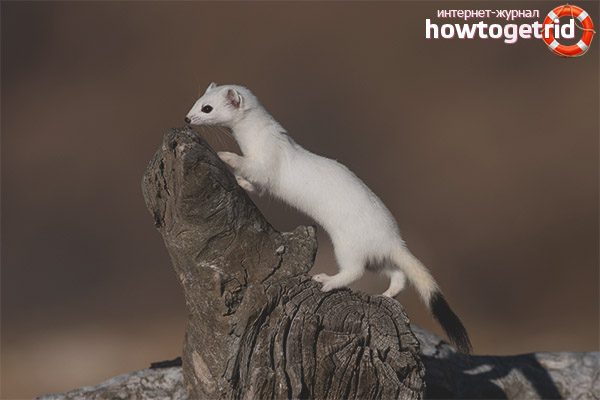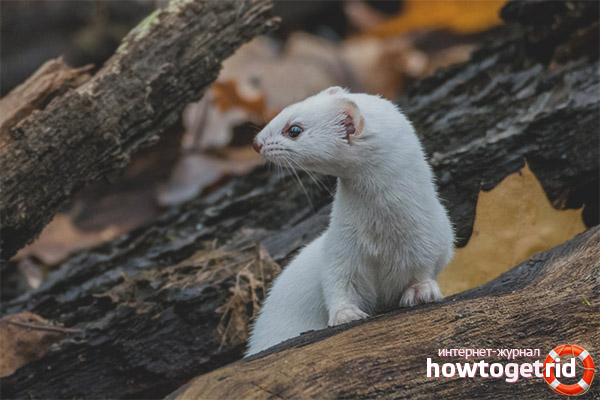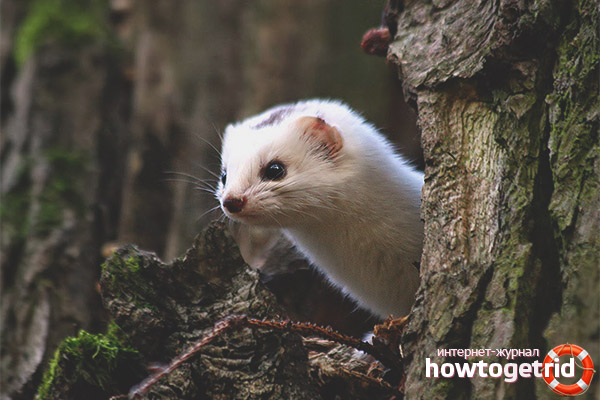The content of the article
Weasel belongs to the family of marten, it is its smallest representative. This predatory animal is extremely mobile, easily climbs on any obstacles, outwardly it gives it a little resemblance to reptiles.
Appearance characteristic
It has an elongated body, thin, characterized by great strength. It has a powerful neck, a relatively short tail and short legs, with sharp claws. The muzzle is small, dull, only slightly larger than the thickness of the neck. She has bead-like dark eyes, a slightly bifurcated nose. The ears are widely spaced small in size with a rounded shape. This animal has the ability to warn the enemy and mark his land with an unpleasant odor. The secret with this aroma is secreted by the glands located near the tail. The weights and sizes of females and males are different. Males are superior to females in both weight and size. Their length varies from 13 to 26 cm against 12-20 cm in females. The body weight of males in the range of 40 - 250 g, in females 30-120 g.
The color of the petting coat changes at different times of the year. In the summer months, the fur has a brownish-brown color, beautifully shiny in the sun. In autumn and winter, the weasel coat is white. By its density, the fur does not change, it is the same all year round. In winter, the length of hairs is longer than in summer.
Animals living in the northern latitudes have a soft and silky fur coat compared to their southern counterparts. Weasels living in warm areas often do not change the color of the hairline for the winter.
Where dwells
The animal can be found in Asia, Europe, on the North American continent. In Russia, weasel lives almost everywhere. The exception is the islands of the northern seas. Depending on the geography of habitat, the animal has several subspecies. The Caucasian, Transcaucasian, Central Russian, Central Asian, Transbaikal and Siberian weasels are distinguished.
The population density of the animal is not the same everywhere, this indicator depends directly on the amount of food (rodents) and the presence of ermine on the territory of the main competitor. The habitat of the animal can be very different, where there are many mice and other small rodents: steppes, deserts, taiga, mountains, tundra. He chooses for the edge of the forest, clearings, deforestation, ravines, the banks of reservoirs, the outskirts of fields. He likes to settle near human dwellings in the countryside - sheds, barns, stacks of straw, stables.
Weasel does not build a hole for himself. She settles in the dwellings of the killed rodents. It may have several such minks; the animal closes its bottom with dry leaves, mosses or grass.
Weasel is a settled animal with its own hunting zone. This territory is small in size, does not exceed 10 hectares. Its borders are marked with affection with a substance with a smell. The hunting zone is divided into several sections, which she visits in turn. Up to 2.5 km can be covered per day.
Lifestyle
Weasel is distinguished by its impudence, agility, dexterity, aggressiveness and bloodthirstiness. Despite its small size, the beast is a great danger. Thanks to her distinctive abilities to swim, jump, climb, there are practically no barriers for her. It can creep into a narrow slot in a small hole. An example of this is her raids on personal subsidiary plots of people. During the night, the animal can completely destroy the livestock of partridges, chickens, chickens, young rabbits, chicks of other poultry. Moreover, he does this not in order to eat, but in the heat of hunting excitement. Otherwise, how to explain the fifty chickens with gnawed heads that the hosts can find in the morning in their chicken coop if a weasel has settled nearby.
In nature, the weasel's diet consists of mice, field voles, moles, a bear, shrews, and small birds. As well as hamsters, fish, amphibians, and other small rodents. The structural features of the body allow to penetrate into the mink of rodents without difficulty. Weasel kills its prey in the only way - by biting the base of the skull. Those animals in which it is difficult to do because of their larger size are less likely to fall on the table of the animal. These include gophers, rats, and similar-sized animals.
Likes to feast on any eggs. Drinks them, making several holes. With a lack of habitual food, does not refuse large insects, snails, small snakes, crustaceans. He eats medium-sized fish, which he can get, knowing how to swim well. A day caress requires food in an amount of 40 g.
With an abundance of feed, weasel kills much more than it needs to eat, making supplies. Often in her shelters lie rodents in an amount of more than one dozen. For hunting, prefers the dark, although it can get food during the day, but, as a rule, in bad weather. Inspecting its territory, the animal does not miss a single object of interest to the hunter: stumps, pits, humps, fallen trees. In winter, while hunting, it leaves for a long time under the snow. When severe frosts, hunting takes place exclusively under the snow.
In winter, the animal does not have a permanent refuge. Leads a land life, avoiding being in open space. Resting under the rubble of brushwood, in the roots of trees, in stacks of straw, hay. It can settle in the folded wood of a villager, in the nest of the mouse eaten by it. If its nest is detected by outsiders, the animal leaves it. Cubs also transfers to another place. A caress is capable of sacrificing herself, completely defending herself from danger and defending her offspring.
Breeding
On the mating season, gestational age, accurate data are not available. The literature says that it all depends on the amount of feed and favorable weather conditions. Usually this is the month of March, but with plentiful food they can multiply year-round.
Male individuals are not distinguished by the principles of monogamy; during the mating season, they mate with several individuals of the opposite sex. The number of cubs in the brood usually varies from 4 to 7; each female has 2-3 broods per year. Being born blind, with a rare fluff on the body, they remain with their mother until they reach the size of an adult. As a rule, it is 3-4 months. By the time an independent life begins, the cubs reach puberty.
The animal moves in jumps 18 - 25 cm long. On a snowy infusion, such jumps create a single chain pattern. They live alone in their territory.
Value for man
Destroying in huge quantities of mice and preventing them from multiplying, this animal regulates their numbers, and this is useful to humans. According to various sources, each animal kills 2 - 3 thousand voles and mice per year.
As a hunting beast, caress is not of interest to humans because of the small size of the skin and the difficulty in its production. There is evidence that in ancient times, petting was used by pets for mouse hunting. In this capacity, the animal ceased to exist when it could not cope with the bred rats and was replaced by cats. Weasel life does not exceed 8-10 years.
Video: Weasel (Mustela nivalis)












Submit